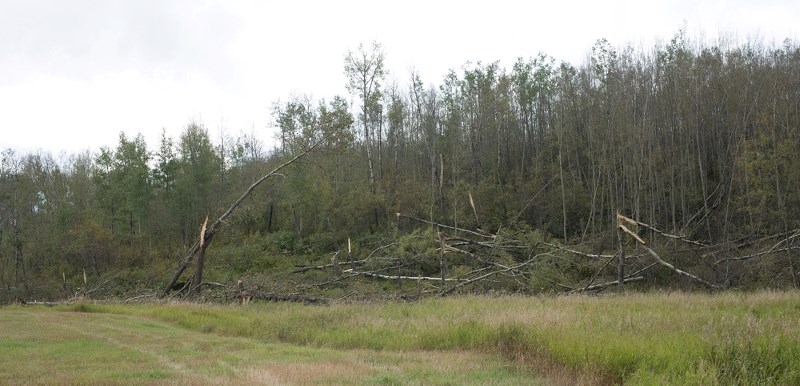It took a couple days for Sharon Lundgren to stop shaking, after a terrifying experience that wreaked havoc in their yard and on nearby land and roads on Sept. 2.
A system of thunderstorms moved through the St. Paul and Elk Point areas on the evening of Sept. 2, with one to two inches of rain reported in a short period of time in some areas. Hail was also noted in areas southeast of St. Paul, in the Armistice area.
Sharon and her husband Gordon live less than two miles off Armistice Road, down Range Road 81. They also pasture their horses on land located in the valley, along Armistice Road.
When the storm came through rather unexpectedly, it ripped apart their yard, tossing trees, damaging a fence, and blocking their driveway with debris. By Tuesday, Sharon felt ready to take a ride and once again inspect the damage, although she admitted that driving through the area, and seeing large trees broken, twisted and uprooted, brought up the feelings she experienced Friday night.
“I’m still shaking,” she said, as she drove through a field located alongside her home.
As she reached the top of a hill, after driving through the area that had clearly been soaked with rain, the damage was obvious. An entire section of large trees were bent in half, some damaged in a way where you could see through their trunks, and others with their roots plucked from the ground.
Well-used pathways in the land, used to access cattle owned by her brother-in-law, were blocked off by trees that would soon have to be cut with a chainsaw, or possibly moved with heavy machinery.
Closer to the Lundgren’s home, chunks of a nearby neighbour’s crop still hung in the power lines, three days after the storm moved through. Sharon laughs at the sight, saying there was a lot more hanging a couple days before, and she had joked with the neighbour about how he would harvest the crop with it hanging on the lines.
“We’ve had plow winds before, and it was nothing like that,” says Sharon, when speaking of the experience.
Sharon and her husband are both convinced it was a tornado that moved through the area. She says it sounded like “a jet” when the winds came through, and the damage appears to have occurred along a path, possibly two paths.
The Lundgren’s have a number of pets, and somehow, all of them were unscathed, including five kittens that found cover under the deck, and a dog that found itself tangled up in some of the debris.
“That’s a miracle in itself,” says Sharon.
She and her husband were also safe inside their home, although she recalls feeling like the house was shaking.
“Then, it just stopped. Like someone said, ‘nope!’”
Kirk Torneby is a warning preparedness meteorologist with the Meteorological Service of Canada, Environment and Climate Change Canada. He took a look at photos taken by the Journal of damage caused by the storm, and looked at the atmospheric conditions on the day of the storm.
He says, “It is unlikely the damage was caused by a tornado.”
He notes that there was a cluster of thunderstorms that pushed northwards through the St. Paul/Elk Point area after 7 p.m. on Sept. 2, and atmospheric conditions were favorable for the development of thunderstorms with wind, heavy rain and large hail.
The Lundgrens reported experiencing all three of those things, with a nearby neighbour noting two inches of rain fell during the storm. The Lundgrens were unsure of the amount of rain at their home since the rain gauge was knocked in the wind.
“Conditions were not favorable for rotating severe thunderstorms,” says Torneby, adding, “A severe thunderstorm watch was initially issued at 6:01 p.m. for the St. Paul area and upgraded to a severe thunderstorm warning at 6:38 p.m. The warning was ended at 7:56 p.m., and the watch was ended at 10:22 p.m.”
Based on his analysis of doppler radar, the absence of any other severe weather reports, and the photos sent to him, Torneby says “this was likely a straight line wind event.”
He added that it is possible that localized winds may have come close to 90km/hour, and that localized higher winds are consistent with the tree damage reported.
“Wind speeds of 75 to 90 km/hr can cause damage, such as trees uprooted or large tree branches (up to 3 inches) broken,” says Torneby, adding, “It is important to note that it is not uncommon to have straight line wind events with stronger winds than you would expect (in excess of 100 km/hr).”
Torneby adds, “Often, damage with straight line wind event isn’t quite as straight as you would think. Straight-line winds are directed downwards from the base of the cloud and then outwards along the ground in a radial direction.”
As an analogy, he offers the idea of dumping a glass of water upside down on a flat surface. The water will spread out as it comes in contact with the flat surface. The spill pattern will depend on the angle the water was dumped, the speed that it was dumped, the distance from the surface, and the amount of water in the cup.
According to the Environment Canada website, “Straight-line winds are winds that move horizontally along the ground away from thunderstorms, sometimes with tornado-like force.” Straight-line winds are also known as microbursts, downbursts, squall lines, plough winds or derechoes.
The website also notes “Straight-line winds may produce the same roar like a freight train noise often associated with tornadoes.”
But, despite what Environment Canada says is the most likely cause of the damage, Sharon says she knows what she experienced, and she still believes a tornado ripped through her yard.



